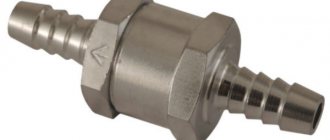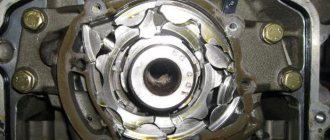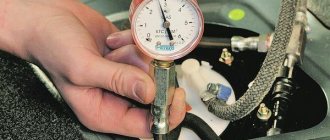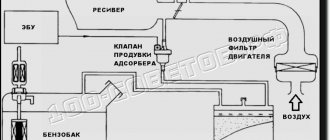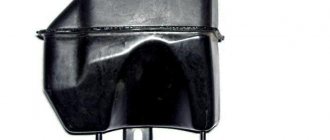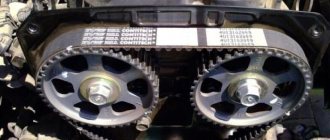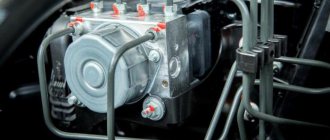Your request regarding the location of the VAZ 2114 EGR valve has been processed. The best repair video and instructions on how to repair can only be found on our website. The presented videos are published with photos. Enjoy watching.
Owner reviews: Cross-country ability. Reliability. Low price of spare parts (and very low quality). Maintainability (work in unequipped places).
To ensure proper operation of the engine and main components, cars use various sensors and controllers. They allow you to monitor the status of systems important to the machine. In this article we will analyze the main sensors on the VAZ 2114 injector 8 valves, their location and purpose.
Engine ECU
Very often the cause of this trouble is the “brain” of the car, that is, the electronic control unit. If any sensor responsible for the correct operation of the internal combustion engine breaks down, or if foreign air enters, the computer cannot give a specific and accurate command to the system, which leads to floating speed. In this case, you should go to a service center and diagnose the ECU, since it is unlikely that you can determine error codes and malfunctions on your own without special tools and devices.
What is the EGR system
To understand the description of checking the functionality of the USR, it makes sense to briefly discuss what kind of system it is, why it is needed and how it works. So, the task of the EGR system is to reduce the level of formation of nitrogen oxides found in the exhaust gases. It is installed on both gasoline and diesel engines, with the exception of those equipped with turbocharging (although there are exceptions). Limiting the production of nitrogen oxides is achieved by sending part of the exhaust gases back to the engine for afterburning. Because of this, the temperature of the combustion chamber decreases, the exhaust becomes less toxic, detonation is reduced as a higher ignition timing is used and fuel consumption is reduced.
The first EGR systems were pneumomechanical and met EURO2 and EURO3 environmental standards. With stricter environmental standards, almost all EGR systems have become electronic. One of the main components of the system is the USR valve, which also includes a sensor that controls the position of this valve. The electronic control unit controls the operation of the pneumatic valve using an electric pneumatic control valve. Thus, checking the USR comes down to determining the functionality of the USR valve, its sensor, and the control system (ECU).
How to determine if the DF is broken?
But how do you understand that the camshaft sensor has failed? The malfunctions that the VAZ-2114 encounters related to reading devices have very similar symptoms. If the engine operates unstable, it begins to “triple”, and the on-board computer shows increased gasoline consumption. These symptoms are common to many breakdowns. If we talk specifically about the phase sensor, then you will definitely receive an error code: 0340 or 0343. The numbers indicate that the camshaft position sensor is faulty or there is an open circuit in its circuit.
The engine control unit does not receive a signal from the DF. Consequently, there is no adjustment of the ignition timing. The engine operation pattern changes. The control unit starts working according to an alternative, “emergency” fuel map. Signals from one or another sensor are excluded from it. The electronic control unit behaves similarly if the lambda probe (oxygen sensor) fails.
View gallery
Location and purpose of devices
We figured out what sensors are used on the VAZ 2114. But if you are repairing your “iron horse” yourself, then you will probably be interested in knowing where the main controllers are located.
Where are the VAZ 2114 sensors located and what functions do they perform:
- Engine fluid pressure controller. This element allows you to calculate insufficient pressure of consumables in the power unit. If the corresponding icon starts to light up on the dashboard, this may indicate problems and malfunctions that have appeared in the operation of the engine. If the indicator on the dashboard has been on for a long time, and the car owner does not take any action to repair his vehicle, this can lead to serious problems. For example, you will either have to do a major overhaul of the power unit, or if the situation is more complex, then it will need to be replaced altogether. It should be noted that the indicator on the dashboard may appear in several cases - when the level of consumables in the system decreases, when the filter element is clogged, when the oil pump breaks down, and also when there are wiring faults. If the engine fluid level has dropped significantly, then perhaps the problem lies in a leak, so it is necessary to find all leaks and eliminate them. Perhaps the indicator appeared on the dashboard as a result of its failure. As for the location, it may differ depending on the type of engine. For example, on engines with 8 valves, the controller is installed to the right and below the valve cover, in the block head. If we are talking about a 16-valve unit, then the meter is placed on the left end of the camshaft bearing housing. It should be borne in mind that if the regulator breaks down, it would be more advisable to replace it with a new one.
- Antifreeze temperature controller in the cooling system; this regulator is also called the engine temperature sensor. This device is located on the intake manifold of the so-called cylinder head cooling jacket. In accordance with the signal received from the device, information about the temperature status of the power unit is displayed on the dashboard. Thanks to it, the car enthusiast will be able to know to what temperature the engine has warmed up, and this data is extremely important, especially when the power unit overheats. As for checking the device, diagnostics can be done at home. To do this, you need to connect a multimeter to the mechanism and switch it to ohmmeter mode, and put the controller itself in a vessel with antifreeze. Next, the container heats up, and in accordance with the temperature change, resistance diagnostics are performed. If these data correspond (the detailed table is indicated in the service book), then the DTOZH is operational.
- Antifreeze level meter in the cooling system. As the name implies, this device allows you to determine the volume of remaining consumables, so that if there is a shortage, the car owner can supplement the volume. The meter is mounted in an expansion tank with consumable liquid and it is equipped with a thread, so it is screwed into the mounting location, and power is connected to its end.
- Brake fluid level meter in the system. From the name it is clear why it is needed, because operating a car with a low level of brake fluid can lead to tragic consequences. This itself is a float-type controller, which is mounted in an expansion tank with consumables.
- IAC or idle air regulator. This element is designed to ensure stable idle speed; it allows air into the power unit at idle speed, bypassing the throttle position sensor. If the device fails, the idle speed will float. The part is mounted directly on the throttle, next to its damper.
- Mass air flow sensor - of all the regulators, this is the most expensive device. Using this controller, the control unit allows you to determine the volume of air consumed, as well as adjust the ratio of air and fuel to form a combustible mixture. The latter is subsequently supplied to the engine injectors. If the unit fails, this can lead to a decrease in engine power and problems with the engine idling. The part is mounted on the air filter element housing, not far from the inlet line.
- Speed. Mounted on the gearbox and allows the driver to monitor the speed at which the car is moving.
- Fuel level in the tank. The float-type device is located in the “four” gas tank. If it breaks down, the fuel volume will be displayed incorrectly on the dashboard.
- TPS is a unit that operates in conjunction with the idle air control; it is also called the gas pedal position sensor. This part allows you to determine the degree of throttle opening. If it breaks, the engine will not respond to pressing the gas pedal, and the engine speed may also increase arbitrarily. The mechanism is located directly on the throttle.
- DPKV is designed to synchronize the control unit and the vehicle engine. It is located near the generator unit drive pulley.
- DPRV, used to determine phased injection, is installed on the side of the air filter element, close to the cylinder head cover. In accordance with the position of the camshaft, the regulator transmits a signal to the control unit, resulting in injection before the valve opens. Fuel is thrown in simultaneously with the air flow.
- Lambda probe or oxygen sensor. The regulator allows you to determine the amount of oxygen that is available in the exhaust system, as well as adjust the combustible mixture. Installed in the receiving manifold, next to the resonator. The device transmits an impulse to the control side about the volume of oxygen concentration in the exhaust gases.
- Detonations. The device detects vibrations in the operation of the power unit and automatically adjusts the ignition angle. In “fours” this part is mounted on cylinders 2 and 3, on the fan side.
What is an EGR valve
The operation of the valve is quite simple - part of the gases from the exhaust system is mixed with air from the exhaust manifold. If the percentage of nitrogen oxide is too high, this leads to high temperatures in the combustion chamber. We all know from school that oxygen acts as a catalyst for combustion. And gases from the intake manifold, mixing with the air flow, minimize the percentage of oxygen. As a result, the combustion temperature decreases and toxicity decreases.
How the USR system works
Everything will depend on the engine on which such a valve is installed. In diesel engines, the valve will be open already at idle speed, and will provide 50% of the intake air. As soon as the engine speed increases, the valve will gradually close. And it will close completely as soon as the engine speed reaches its maximum value. When the engine warms up, the valve will also be completely closed. During idle speed of the internal combustion engine, the USR valve will be closed, and it will not turn on at maximum engine speed. In other engine operating modes, the EGR valve supplies air to the intake from 5% to 10%.
Methods for eliminating floating engine speeds
When starting to find and eliminate the reasons that cause unstable operation of the engine in idle mode, you first need to check:
- Condition of the air filter and spark plugs. If they become critically dirty, they need to be replaced.
- Integrity of insulation of high-voltage wires. If damage is found, they must be replaced.
It is recommended to make sure that there is no suction at the junction of the intake manifold with the engine cylinders. To do this, with the engine running, you need to sequentially spray all joints at the joints with carburetor cleaner or other flammable liquid. If atmospheric air enters there, the car engine jerks sharply, which is why, if a damaged gasket or plug is detected, the element is replaced.
Checking the tightness of the intake manifold (video guide)
Let's consider the remaining elements of the car, the malfunction of which can affect the smooth operation of the VAZ 2114 engine in idle mode.
Solenoid valve diagnostics
Cars with engines equipped with a carburetor are equipped with idle speed solenoid valves. Devices are checked as follows:
- Disconnect the power cord.
- Start the engine to warm up.
- Connect the wire. If a clear click is not heard, the part must be replaced.
Attention! To fully ensure that the valve is working properly, be sure to clean the nozzle and repeat the test.
Adjusting the idle speed on a carburetor engine (with video)
Note that the main reason for the appearance of floating idle speed in engines of this type is the incorrect operation of the carburetor. The device is adjusted by rotating the fuel quality and quantity screws.
Is the EGR system on the injector working?
"Floating" speed can be caused by jamming of the exhaust gas recirculation (EGR) valve, which is installed in the exhaust manifold. It is necessary to periodically remove dirt from the valve seat and its seat using a carburetor cleaning aerosol, avoiding liquid getting on the sensor diaphragm.
Keep the valve seat clean
Attention! If cleaning the unit does not give a positive result, the device must be replaced.
Is the idle air control valve working correctly?
The IAC is checked by measuring the electrical resistance at the contacts - to diagnose the device you will need a tester (multimeter) set to the “ohmmeter” operating mode. To check the details:
- Let's turn off the ignition.
- Disconnect the connection block.
- Let's measure the resistance on contacts A - B and C - D of the device. The optimal readings of the device vary from 40 to 80 ohms.
- Let's repeat the measurements with contacts B - C and A - D. In this case, the multimeter should show “infinity” or an open circuit.
Where is the device located (examples).
Finding the USR valve is not difficult - it is installed on the car engine in close proximity to the intake manifold. The location and appearance of the product depend on the make and model of the car:
- Opel Astra G the device should be looked for under the upper right corner of the protective cover;
- Ford Transit VI (diesel) - in the front of the engine, to the right of the oil dipstick;
- Volkswagen Technical - on the intake manifold flange;
- Opel Omega – to the right of the ignition distributor;
- Ford Focus – in the area of the air filter under the pipes;
- Peugeot 406 (2.1 TDI) – directly above the engine, next to the intake manifold;
- Chevrolet Lacetti - next to the ignition module (checking and maintenance will not require even dismantling the protection).
That's why you need to take the EGR valve seriously: it's small and clever.
If the EGR valve stops working correctly, then certain symptoms may appear in the car, clearly indicating to us that the exhaust gas recirculation system is faulty. Fortunately for you and me, most often this does not mean that it is time to change the valve itself. In many cases, we can easily fix everything ourselves.
Mass air flow sensor (MAF)
The mass air flow sensor is located in the engine compartment of the VAZ 2114 and is one of the most recognizable car sensors. The mass air flow sensor is attached with two bolts to the air filter box. The mass air flow sensor is responsible for counting the air intake from the engine and transmits the readings to the above-mentioned ECU. The mass air flow sensor is directly related to the formation of the air-fuel mixture.
Signs of a DMRV malfunction:
- Deterioration of car dynamics;
- Increased fuel consumption;
- Floating speed at XX;
- When starting the internal combustion engine, you have to turn the starter for a long time;
Replace the EGR valve or clean it - Which is better?
On some engines the EGR valve is easily accessible. But on many cars, in order to get to the exhaust valve, it is necessary to disassemble half the engine. In this case, just removing the valve will cost you a pretty penny. Especially if there is a defect in the valve and you have no choice but to remove the valve from the car. It is worth noting here that if in your car, in order to get to the exhaust valve, you have to dismantle many components in the engine compartment, then there is no point in cleaning it, etc. work. In this case, it would be more advisable to simply install a new valve, since when cleaning it in the future, you may need to remove it from the machine again, which will again be associated with huge financial costs.
We also draw your attention to the fact that when replacing the EGR valve with a new one in many cars, you may need to re-register the new valve in the engine control unit using a computer. That is, in essence, you will need to teach this new valve to work exactly as it was intended by the automaker.
As you already understand, friends, to set up the operation of a new valve, you need special diagnostic equipment (a computer automotive scanner). If you do not have such a device, then after replacing the exhaust valve you will have to contact a technical auto center.
Sensors and their malfunctions
Of course, if the ECU issues incorrect commands, this does not mean that it is faulty. The cause of breakdowns should be sought in the following sensors:
- IAC (idle air regulator).
- MAF (mass air flow sensor).
- EGR.
It is because of these parts that the speed on the VAZ-2114 most often fluctuates.
If all these elements are working correctly, you should diagnose the spark plugs and check the condition of the air filter. By the way, sometimes the cause of floating speed is not the sensor itself, but its electrical wiring.
Why does the idle speed fluctuate on carburetor engines?
The VAZ-2114 Samara with a carburetor internal combustion engine is also not immune to this problem. This happens, fortunately, not every day, but still. The main reason for this is an incorrectly adjusted or faulty carburetor itself. Also, floating speed can be caused by air leaks or a faulty XX solenoid valve. In addition, it is worth checking the air filter for deposits.
But most often, floating speeds arise precisely because of incorrect carburetor adjustment. In this case, you should adjust it by correctly rotating the fuel quality and quantity screws.
As for the solenoid valve, it can be diagnosed without removing the power wire from it. With the ignition on, it is enough to touch the contact on the valve with the cord - a characteristic click should soon appear. If it is not there, you can try to touch the contact with the wire that is connected to the positive terminal on the battery. If after this you do not hear a click, then most likely the valve has malfunctioned. To repair it, you need to unscrew it and clean the nozzle.
So, we found out why the speed on the VAZ-2114 fluctuates and how to fix this problem depending on the type of fault.
The five-door hatchback VAZ 2114 is a restyled model of the famous “nine”, which rolled off the assembly line of the car plant from 2003 to 2013. At various times, the manufacturer installed on the car power plants with carburetor or distributed fuel injection (injector) of its own making, and since 2007 the car has been equipped with an electronic engine control system. Note that all these engines have one common and very significant drawback - when they switch to idle mode, their crankshaft speed suddenly begins to “float”.
How much does it cost to repair an IAC at home?
Cleaning the idle speed sensor will help bring it back to life.
Despite the fact that the instruction manual for the “fourteenth” Lada does not recommend looking for an alternative to replacing the IAC, many people practice repairing the sensor with their own hands. To carry out restoration work, you need:
- remove the sensor, clean its body and pull out the 3 fixing pins (rivets);
- after this, you can carefully remove the case - so as not to disturb the solder spots of the wires;
- very often the cause of failure is a broken contact - in this case, you need to solder the wiring in place and cover the soldering area with varnish (to prevent corrosion);
- Another problem may be air leakage through the idle air sensor - to solve the problem, you can use a regular sealant, which will eliminate the gaps in the IAC housing;
- If it turns out that the needle guide drive or the guide itself is worn out, repairs will not be possible.
All repair options will require purely symbolic investments, as well as a minimum of time and experience of the performer.
Symptoms of a problem
There are a number of external signs that indicate that there is a problem with the system, and in particular with the EGR sensor. However, the signs below may indicate other malfunctions in the engine, so additional diagnostics of both the system as a whole and the valve in particular are necessary. In general, the symptoms of a non-functioning EGR valve will be the following:
- Reduced engine power and loss of vehicle dynamic characteristics. That is, the car “does not pull” when driving uphill and when loaded, and also accelerates poorly from a standstill.
- Unstable engine operation, “floating” speed, especially at idle speed. If the engine is running at low speeds, it may suddenly stop.
- The engine stalls shortly after starting. Occurs when the valve is stuck open and the exhaust gases flow into the intake in full.
- Increased fuel consumption. This is caused by a decrease in vacuum in the intake manifold, and as a result, an over-enrichment of the air-fuel mixture.
- Generating errors. Often, the “check engine” warning light is activated on the dashboard, and after performing diagnostics with scanning devices, you can find errors related to the operation of the USR system, for example, error p0404, p0401, p1406 and others.
If at least one of the listed symptoms appears, it makes sense to immediately perform diagnostics using an error scanner; it will make sure that the problem is in the EGR valve. For example, Scan Tool Pro Black Edition makes it possible to read errors, view the performance of various sensors in real time, and even adjust some parameters.
OBD-2 scanner Scan Tool Pro Black
works with protocols of domestic, Asian, European and American car brands. When connected to the gadget via popular diagnostic applications via Bluetooth or Wi-Fi, you get access to data in the engine blocks, gearbox, transmission, auxiliary systems ABS, ESP, etc.
With this scanner you can see how the solenoid valve of the vacuum regulator is activated (details at the end of the article). Having such a device, you can quickly find out the cause and begin to eliminate it. Checking the valve in a garage is quite simple.
Knock sensor(DD)
The knock sensor is installed on the cylinder block between cylinders 2 and 3. The functions of the sensor are to detect detonation during engine operation and transmit the received signals to the ECU. The sensor is made on the principle of a piezo element and has a simple design.
Signs of DD malfunction:
- High fuel consumption;
- Vibrations during internal combustion engine operation;
- Jerks when moving;
EGR valve for VAZ 2114
Stronger is needed, 2 - 3 pieces in series, it will just be a little easier to release at high speeds
Then the last question for today. How to calculate the internal cross-section of a pipe?
As a rule, the internal diameter of the pipe is half the diameter of the cylinders from general statistics
Thank you very much for your answers, I'm looking forward to the next videos. Is it possible to contact you not only through YouTube, but also by mail or ask, perhaps it was somewhere, but I can’t find it?
Email me at the end of the video
where can I buy this issue?
Just do it yourself:
I had this idea about your muffler. If you weld threaded tubes, you can change their depth by screwing in the bolts. This way you can choose the optimal parameters to eliminate the sound at low speeds too. That is, it will turn out to be a test bench
Zhenya, what do you think about the turbo compound?
question - 4 in 1, where 1 with an expanding cross-section and 4 are connected in series???
Good afternoon, the car is a Logan engine 1.6 8kl, there is a spider 4-2-1 ending with 51 pipes, how long should the strongers be, their number, and did I understand correctly that they replace the resonator?
Hello, Evgeniy. Will there be a video about the EGR valve and its plug? I would really like to understand many of the theoretical subtleties, and I’m also interested in practical correct solutions. THX.
0, 18, 0 injectors supply fuel only once, during intake. It’s another matter if the dpkv is faulty, then as was said, the consumption increases. The ECU does not see which cylinder is on the intake stroke and supplies both with half, in fact apparently a little more. All this applies to the ZMZ 406. Yes, by the way, the spark just strikes 2 cylinders at once in pairs 1 and 4, 2 and 3
Well done and Mina painted everything clearly and showed it super
Thank you very much, everything is clearly understandable and, most importantly, very informative and rich, I spent 3 days on all sorts of forums, collecting bits and pieces and, as it turned out, I read a lot of crazy ideas. And here a lot is clear and correct.
Evgeniy, thanks for the video. As I understand it, the optimal volume of the exhaust pipe from each cylinder is 1.8-2. 5 from the volume of the cylinder TO the junction into a common pipe. I think I understand this. Tell me, what if it is possible to make a direct flow directly into the atmosphere from each cylinder, that is, release 4 pipes from the hood. What diameter should the pipes be and what volume should each be? Engine ZMZ 402, carburetor K-126, standard camshaft, standard intake. Don’t be surprised, we are talking about a car for auto battles for survival. There, any pipes under the bottom are only harmful, but they can be removed from the hood. No matter the sound or toxicity. Thank you. Z.Y. Greetings from Oleg Nesterov, a young participant in auto battles for survival
What if we make a separate outlet for each cylinder? That is, do not combine the release. And how many cylinders there are so many exhaust pipes. What will happen?
you know... I watched a few of your videos... sorry, I just can’t understand for myself... whether it is necessary to turn off the EGR valve or not... that is, there are no obvious advantages... I have a Chrysler Crossfire, it has a Merenovsky engine 112. Volume 3. 2 V6 - 224 hp and 315 torque at 3 thousand rpm... And someone says that there is no need to turn off, someone says that the shutdown valve leads to overheating and increased fuel consumption... and I’m already completely confused... Please shoot me: Then I want to saw off the rollers and install flame arresters . I won't put up any spiders. I have a standard one... but this EGR valve... why should I remove it... or leave it alone?
Krasnoyarsk is here
Causes of EGR system malfunctions
There are only two main reasons for malfunctions of the EGR valve and the system as a whole - too little exhaust gas passes through the system and too much exhaust gas passes through the system. In turn, the reasons for this may be the following phenomena:
- Carbon deposits form on the EGR valve stem . This happens for natural reasons. As mentioned above, exhaust gases pass through it, and soot settles on the walls of the valve, including the stem. This phenomenon is especially aggravated when the machine operates in aggressive conditions. In particular, with engine wear, an increase in the amount of crankcase gases, and the use of low-quality fuel. After diagnosing the valve, it is always recommended to clean the stem using carb cleaner or a similar degreasing cleaning compound. Often, some kind of solvent (for example, white spirit) or pure pure acetone is used for this. You can also use gasoline or diesel fuel.
- EGR valve diaphragm leaking This malfunction leads to the fact that the specified valve does not open or close completely, that is, exhaust gases leak through it, which leads to the consequences described above.
- The EGR system channels are coked . This also results in exhaust gases and air not being able to flow through them properly. Coking occurs due to the appearance of carbon deposits on the walls of the valve and/or channels through which exhaust gases pass.
- The EGR system was not turned off correctly . Some car owners who regularly encounter the fact that due to the use of the designated system the engine loses power simply turn off the EGR valve. However, if such a decision has been made, then this must be done correctly, otherwise the air flow meter will receive information that there is a very high air flow. This is especially true when buying a used car, when the new owner does not know that the EGR valve on the car is plugged. If the car is equipped with such a system, then it is advisable to ask the former car owner about its condition, and also ask whether the USR system was completely turned off.
- The EGR valve is stuck when closing and/or opening. There are two possible options here. The first is that the sensor itself is faulty and cannot transmit correct data to the electronic control unit. The second is problems with the valve itself. It either doesn't open completely or doesn't close completely. This is usually due to a large amount of carbon deposits on it formed as a result of fuel combustion.
- EGR valve movement is jerky . A working solenoid should ensure smooth movement of the rod, and accordingly, the sensor should record smoothly changing data on the position of the damper. If the movement occurs abruptly, then the corresponding information is transmitted to the ECU, and the system itself does not operate correctly with the consequences for the engine described above.
- On those cars where the valve movement is provided by a stepper electric drive , a possible reason lies precisely in it. In particular, the electric motor may fail (for example, the winding may short out, the bearing may fail), or the drive gear may fail (one or more teeth on it may break or be completely worn out).
Features of the exhaust gas recirculation system
The EGR valve is located between two manifolds (intake and exhaust) after the throttle valve. The vacuum cavity of the device is combined with the intake manifold.
When the engine is idling, the throttle valve is closed and there is no vacuum in it.
In this mode, there is almost no formation of nitrogen oxide. As a result, the idle speed is stable and the engine runs smoothly.
As soon as the loads increase, the throttle valve opens and a vacuum of air appears behind it.
The latter acts on the system diaphragm and promotes the opening of the valve. As a result, even at medium loads the EGR system actively performs its functions.
When the engine speed increases and the engine operates at maximum load, the throttle valve opens completely. The result is a reduction in vacuum to a minimum level.
The valve closes and the power unit produces maximum power. This operating algorithm is justified, because in maximum load mode the operation of the exhaust gas recirculation valve will be ineffective.
Thus, the EGR system only starts at medium speeds. But there is one minus. The EGR is started after the power unit has been started, before the latter has had time to warm up.
Because of this, the engine heating time increases and interruptions occur at idle.
The problem is solved in a simple way - by installing a special thermal valve directly in the vacuum tube. In this case, installation can be performed on the cooling pipe or radiator.
The operating principle of the thermal valve is simple. Until the motor warms up, the vacuum channel is securely closed by the device. In this case, the ERG valve also does not work.
As soon as the power unit warms up to operating temperature, the thermal valve opens and allows the Exhaust Gas Recirculation system to operate. This is a simple way to prevent the valve from operating on a cold engine.
Idle mode
Idle speed is the operating mode of a car engine with the gear in neutral. It is characterized by minimal engine load and low fuel consumption.
Idle mode is used:
- for delivering motor oil from the engine crankcase to friction units after a long period of parking the vehicle;
- to warm up the power unit in the cold season;
- in cases where turning off the motor is impossible or undesirable.
During normal engine operation, the crankshaft speed is idling at 2000 rpm. gradually decrease to 800, then maintaining at this level. However, it also happens that the power plant, when switching to this mode, operates unstably - it randomly changes the speed in the range of 500–1500 rpm, “chokes” and stalls. This tells us: a failure has occurred in the engine control system, the causes of which must be diagnosed and eliminated as soon as possible.
The movement of the arrow of the device shows the change in the number of engine revolutions
Determining the specific cause of the malfunction is not easy, but it cannot be ignored - this can lead to critical engine failure and the need for expensive repair work. In addition, driving a car with an engine that is unstable at idle speed distracts the driver's attention. He has to constantly monitor changes in the speed and keep his foot on the gas pedal, preventing the engine from stalling when braking or stopping briefly.
What sensors are on the VAZ 2114
Sensors are installed to signal the status of systems, liquid levels, and emergency situations. They are located on the engine units, transmission, body and in electronic circuits. Almost all VAZ 2114 sensors are installed standard on production vehicles. However, some can be supplied by the car owner independently or during tuning of the car, as an additional option.
List of main measuring instruments located on serial VAZ 2114, this is the sensor:
- oil pressure;
- antifreeze temperature;
- antifreeze level;
- fuel level;
- idle move;
- mass air flow;
- fluid level in the brake system;
- throttle position;
- speed;
- crankshaft position;
- camshaft position, also known as phase sensor;
- oxygen;
- detonation;
- uneven road;
- ambient air temperature.
The list is quite extensive, but car owners are not complacent and are improving their cars by installing additional devices. The options most often set are:
- device signaling open doors;
- front brake pad wear gauge;
- light sensor device.
How to clean?
First of all, stock up on the necessary tools: a screwdriver, spanners and open-end wrenches, lapping paste, rags and carburetor cleaners - foam and spray.
Find out the type of device installed in the machine. The pneumatic one needs to clean the seat and rod, the electric one needs to clean the filter that protects the vacuum system from clogging.
Repairs are carried out in the following order:
- Turn off the power supply to the on-board network by removing the battery terminals.
- Provide access to the USR valve (different actions are required for a specific car model),
- Unscrew and remove the clamps securing the pipes and disconnect them from the device.
- Unscrew (preferably with a ratchet) the fixing bolts. You need to be careful with the bottom pair of nuts - the fasteners are easily lost.
- Remove the USR, remove it from the engine compartment, soak it in carburetor wash for 5-10 minutes.
- Clean the parts with a rag containing cleaner.
- The EGR valve is assembled and installed in the reverse order.
The following conditions must be met:
- after dismantling, the USR gasket is always replaced with a new one;
- the correct connection of the vacuum tubes and their integrity are subject to mandatory verification;
High-temperature sealant is applied to the threaded connections of the thermal valve; in addition, tightening forces should be controlled, otherwise leaks cannot be avoided.
Video instructions for cleaning the device.
Why is this happening?
This problem often occurs in poorly maintained cars: a busy work schedule, high load on the car, low-quality fuel and even laziness of the car enthusiast ultimately lead to problems with the car’s operation.
The engine is not only the main part of the car, but also the most sensitive. At the same time, when one or more of the above circumstances affect the operation of your car and your VAZ 2114 stalls at idle, it’s too late to deal with the possibility of preventing a breakdown.
